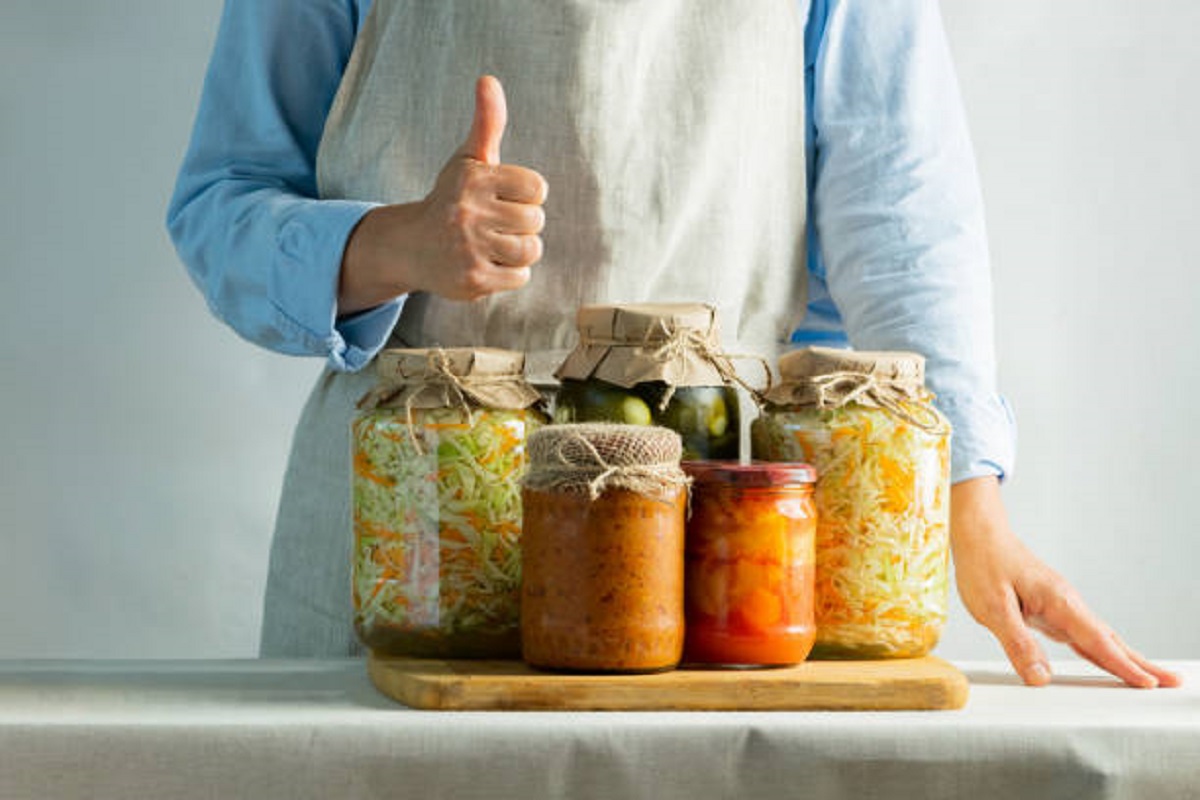DANONE PROBIOTICS VS HOMEMADE FERMENTED FOODS: SAVE MONEY & ENHANCE GUT HEALTH
I’m staring at the back of a probiotic yogurt cup, and I’m wondering: “Why does gut health suddenly feel like rocket science?” Danone and other big brands toss around words like, live cultures, microbiome, bifidobacteria, and I’m just here trying to figure out if this $3.50 cup of yogurt is worth it.
Hey, I don’t want to be trashing Danone or anything. They need to give their marketing team a raise. But here’s what’s keeping me awake at night: “are we paying premium prices for something our grandmothers used to make in mason jars?”
Today we’re diving into the issue of Danone probiotics vs homemade fermented foods. Warning: your wallet might thank you for reading this.
WHAT ARE PROBIOTICS, ANYWAY? (Let’s Start from Scratch)
Now that we’ve set the stage for comparing kitchen chemistry to corporate probiotics, let’s begin from scratch. Probiotics are live beneficial bacteria that support your digestive system.They are the good guys in your gut’s ongoing fight against inflammation, poor digestion, and that post-lunch slump.
Your gut contains trillions of microorganisms, both good and bad bacteria. If the good guys overwhelm the bad ones, you’re fine. But if bad bacteria get the upper hand, you can get bloating, digestive issues, and even mood swings.
DANONE’S PROBIOTIC EMPIRE: WHAT ARE THEY SELLING?
Danone has built a billion-dollar business around probiotic-containing products like Activia yogurt, DanActive drinks, and Two Good yogurt. Their promises are large: “clinically proven to improve digestive health” and “billions of live probiotics in every serving.”
But let’s take apart what you’re actually getting:
Danone Activia ingredients:
– Bifidobacterium lactis DN-173 010 (their own patented strain)
– Lactobacillus bulgaricus
– Streptococcus thermophilus
– Added sugars (typically 12-15g per serving)
– Artificial flavors and stabilizers
The cost breakdown is a punch: A 4-pack of Activia is $4-5, leaving you with about $1.25 per serving for a million billion CFUs (colony-forming units) of probiotics.
And that jar of fermented sauerkraut your grandmother prepared? Naturally occurring species of Lactobacillus, sometimes as many as 100 million to 1 billion CFUs per serving, pennies on the dollar.
HE SCIENCE BEHIND DANONE’S CLAIMS (And What They Don’t Tell You)
Danone invests a lot in research, and I’ll confess, give them credit: there are some studies on their probiotic strains. Their Bifidobacterium lactis DN-173 010 has had some success in reducing digestive transit time and improving regularity in clinical trials.
But here’s where it gets murky:
Study limitations often include:
– Small sample sizes (at times less than 100 individuals)
– Brief studies (2-4 weeks)
– Industry-sponsored research (potential for bias)
– Treating individual symptoms, not overall gut health
Moreover, most studies test their product against placebos, not against naturally fermented foods. It’s the difference between a vitamin C supplement and doing nothing compared to eating an orange.
HOMEMADE FERMENTED FOODS: YOUR DIY GUT SUPPORT SQUAD (Easy Recipes That Actually Work)
Here are some foolproof fermentation recipes that are now staples in my kitchen. They’re not Instagram-worthy, but they work. They are loaded with diverse live bacteria. Unlike the single strains in most commercial yogurts, DIY ferments contain a community of microbes that work together.
Basic Sauerkraut (Your Gateway Drug to Fermentation):
Ingredients:
– 1 medium cabbage (approx. $1-2)
– 1 tablespoon sea salt
– Mason jar
Method:
1. Shred cabbage thinly
2. Combine with salt, massage until softened
3. Pack tightly into jar, leaving 1-inch headspace
4. Weight down with smaller jar or fermentation weight
5. Ferment 3-4 weeks at room temperature
Cost breakdown: Approximately $0.30 per serving compared to $1.25 for Activia.
Quick Kimchi (Gut Health with a Kick):
Ingredients:
– 1 napa cabbage ($2-3)
– 2 tablespoons sea salt
– 1 tablespoon grated ginger
– 3 cloves garlic, minced
– 1 tablespoon Korean red pepper flakes
This ferments faster than sauerkraut: 1-2 weeks ready. The spices add in prebiotics (food for your probiotics) which commercial products often lack.
Water Kefir: The Probiotic Soda Alternative:
For those who are without fizzy drinks, water kefir grains produce naturally carbonated, probiotic-containing beverages. Initial cost for grains is $10-15, and they self-multiply and last forever with good care.
THE REAL COST COMPARISON (Brace Yourself)
Let’s do some late-night calculations that’ll depress or inspire you:
Annual Danone habit:
– Daily Activia: $456 per year
– Daily DanActive: $547 per year
Annual homemade fermentation:
– Sauerkraut ingredients: ~$52 per year
– Kimchi ingredients: ~$78 per year
– Water kefir: ~$30 annually (after first grain expense)
Overall savings: $300-400 annually while being exposed to more diverse probiotic strains.
BUT WAIT, ARE THERE DOWNSIDES TO DIY FERMENTED FOODS?
I’m not here to make homemade fermentation a cakewalk. There are legitimate concerns:
Possible setbacks:
– Investment in time and learning curve
– Inconsistent probiotic quantities
– Risk of contamination through bad technique
– Convenience is what some prefer
Safety notes:
– Always use clean equipment
– Trust your senses, bad ferments reek terribly, terribly bad(Don’t eat)
– Start with small amounts to test tolerance
Yet people have been fermenting food and not damaging themselves for thousands of years. Our ancestors did not have sterile laboratory environments and still lived healthily off fermented foods.
THE MICROBIOME DIVERSITY FACTOR (This Changes Everything)
This is where home ferments really shine: diversity, not strength, wins at gut health. While Danone foods have a standard 2-3 strains of bacteria, fermented foods prepared at home might have dozens of varieties of beneficial microbes.
Recent studies have shown that diversity of the microbiome is a stronger indicator of general health than the quantity of any one probiotic species. Your home-made sauerkraut might have lower total CFUs than Activia, but it contains more varieties of beneficial bacteria.
WHEN COMMERCIAL PROBIOTICS ARE JUSTIFIED
I’m still figuring this out for myself, but commercial probiotics do make sense at times:
Use Danone products when:
– You’re traveling (convenience factor)
– Recovering from antibiotics (special, high-dose strains)
– Having specific digestive issues
– Acclimating to eating fermented foods gradually
Use homemade when:
– Budget is the primary concern
– You enjoy cooking and experimenting
– You want maximum control of ingredients
– You’re concerned about long-term gut health
YOUR ACTION PLAN: GETTING STARTED ON YOUR FERMENTATION JOURNEY
Want to transform your kitchen into a probiotic powerhouse? This is your beginner’s guide:
Week 1-2: Start with sauerkraut
Week 3-4: Add water kefir to your routine
Month 2: Experiment with kimchi or other vegetables
Month 3: Try yogurt or milk kefir (if you tolerate dairy)
Remember, it’s not perfection but progress. Some batches will be great, some horrible. That’s learning.
Q: Is homemade fermented food as good as commercial probiotics?
A: Studies show traditional fermented foods can be as strong, or stronger, due to bacterial diversity, although probiotic numbers can vary from batch to batch.
Q: How long do homemade fermented foods last?
A: Well-fermented foods will store 4-6 months refrigerated, occasionally longer. The acidic environment keeps them naturally preserved.
Q: Will homemade fermentation kill me?
A: There is a risk of contamination but it is slight when technique is correct. Off ferments typically have a strongly rotten odor, use your nose.
Q: Do I need special equipment to ferment?
A: Simple fermentation requires just sea salt, vegetables, and mason jars. Equipment may be used but is not necessary for the beginner.
THE BOTTOM LINE: YOUR GUT, YOUR CHOICE
After much late-night research and experimentation in the kitchen, here’s my frank opinion: Danone probiotics are not terrible, but they are not magical either. They’re easy, portable, and backed by some science. They offer convenience and regular probiotic delivery, but at a higher cost.
Fermented foods prepared at home take more effort upfront but offer better value, ingredient control, and often more diversity of bacteria. And there’s something satisfying about creating your own gut health instead of buying it.
Your best bet? Start with one simple ferment and gradually replace commercial probiotics. Your gut, and your checking account will thank you.
And if you’re looking for more ways to improve your gut health? Visit our blog HARVARD HEALTH’S GUT HEALTH SECRET THAT TAKES 5 MINUTES DAILY
Author: Princess | SEO Health & Wellness Writer, Food as Medicine Blogger
I help stressed, budget-conscious families cut through health jargon with simple, food-based fixes.
Want more easy, science-backed tips? Subscribe for weekly family-friendly nutrition hacks.




